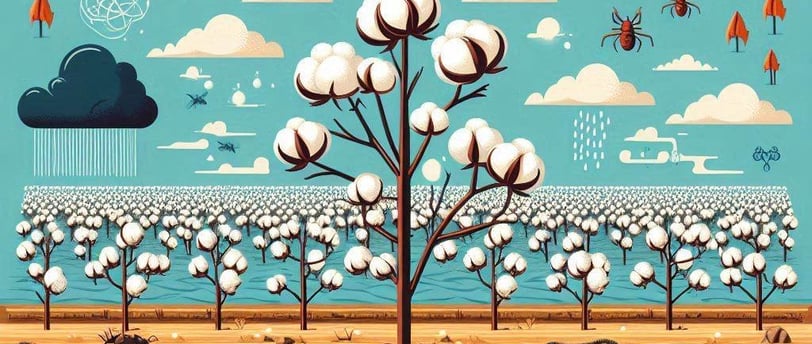Cotton: Pakistan's White Gold Under Threat
Discover the challenges facing Pakistan's cotton industry, from climate change to structural problems, and explore the solutions needed to save this vital sector. Read the expert insights from Dr. Rizwan Maqbool and Zain Shahzad as they delve into the complexities of cotton production in Pakistan and propose a comprehensive approach to ensure its continued dominance in the economy
AGRICULTURE
Dr Rizwan Maqbool Associate Professor, Department of Agronomy, UAF. Zain Shahzad, Student M.Sc. (Hons.) Agronomy UAF. Muhammad Talha Aslam, College of Agronomy, Jiangxi Agricultural University, Nanchang, China.
5/30/20242 min read


Cotton is woven into the very fabric of Pakistan’s economy. One of the largest producers of cotton in the world, the sector makes a major contribution to the nation’s prosperity. Sindh and Punjab are the heart of the agricultural goldrush: both provinces account for the vast majority of the country’s production. But a perfect storm of threats risk derailing this vital part of the economy.
Over the past 20 years, climate change has hung over cotton cultivation like a nemesis. Crops have suffered under unpredictable rains, rising temperatures and eventual water shortages. The Indus River, on which cotton traditionally depended, has been overdrawn, clogged with silt and smeared with human and industrial waste. True to the fickle nature of unpredictable climate change, pests and disease multiply.
So, how to overcome all these obstacles? The answer that can help mitigate these challenges is multifold. Use of water-saving irrigation techniques like drip irrigation is very important. Developing drought-tolerant cotton varieties using through research is also important. Integrated pest management, which is biological, cultural and chemical control of pests, can minimize crop losses.
Then there are its structural problems. Low productivity – compared to global benchmarks – remains a major challenge. Ancient forms of farming are still in place, there is poor access to good quality seeds, and extension services remain inadequate. Farmers need to be better equipped with knowledge and resources. Backing up agricultural research and development to develop high-yielding and resilient cotton varieties is also crucial.
Market access is another constraint, with fluctuating prices, in the absence of meaningful forward markets, often leaving small farmers at the mercy of the market and intermediaries. Strengthening farmer co-operatives can be a vehicle for collective bargaining and realizing better prices. Improving infrastructure, such as roads and storage facilities, can also facilitate market linkages.
Despite these challenges cotton dominates the economy. It employs tens of millions in its production, processing and related services. Cotton exports generate hard currency. Cottonseed oil contributes to food security. The textile sector, that employs a large share of employment, is also totally cotton-based.
The only way to save cotton in Pakistan is a comprehensive approach. Government policy must support the sector, encouraging farmers to shift to better practices. Forward and backward supply chains need to be improved, from the farm to the factory. Investment in research and development is needed to tackle climate issues and pests.
Research into solutions for these problems will help Pakistan maintain its status as a global leader in cotton production, and also unleash the potential of this crop for the whole of its people.
